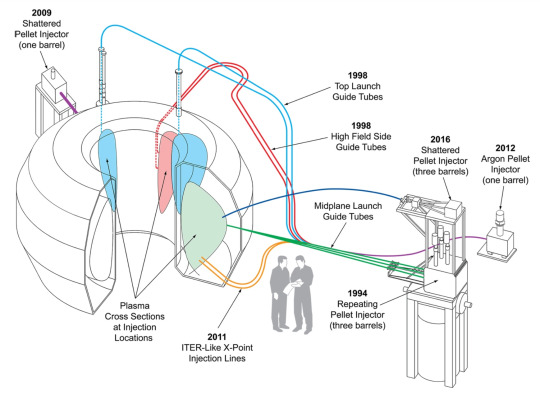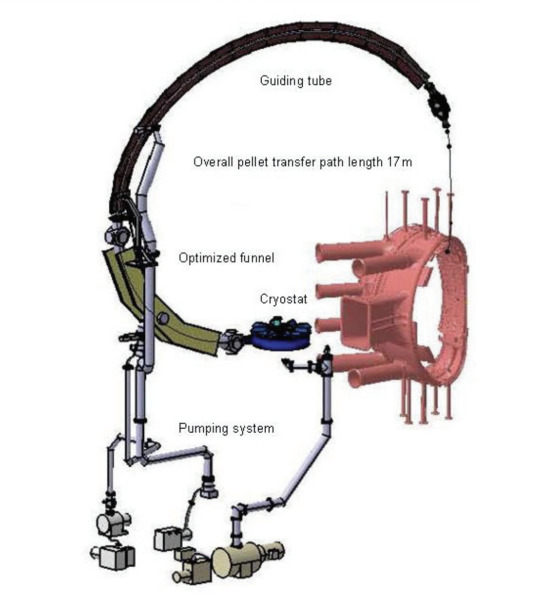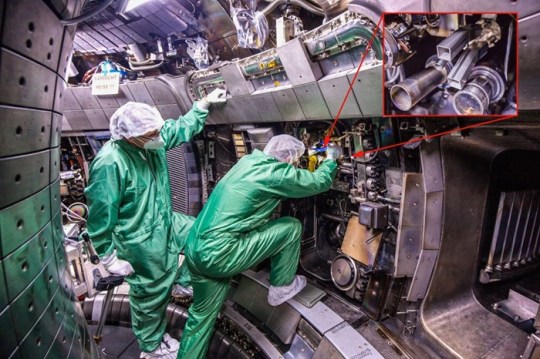#journal of scientific and technical research
Explore tagged Tumblr posts
Text
An Early Excessive Release of Cytokines by Ionizing Radiation Exposure in Macrophages Accentuates Inflammatory Disorders

An Early Excessive Release of Cytokines by Ionizing Radiation Exposure in Macrophages Accentuates Inflammatory Disorders in Biomedical Journal of Scientific & Technical Research
Excessive release of cytokines after radiation exposure reportedly induces inflammatory disorders. To prevent the occurrence of cytokine-mediated disorders, several strategies are employed, including preventing cytokine overproduction in irradiated tissue; however, this strategy is less effective in some tissues, such as the lung, and ineffective at preventing exacerbation of diseases and other disorders. Therefore, to elucidate the mechanisms associated with cytokine overproduction following radiation exposure, we investigated macrophage-specific immune responses resulting in cytokine production by initially assessing their levels in irradiated M1-primed RAW264.7 cells via microarray and computational analyses. We found that differentially expressed genes were mainly related to inflammatory responses and cytokine activity, and that tumor necrosis factor- α, interleukin (Il)-1, and Il-7 overexpressed at 0.5-h after radiation exposure, with these early cytokines important to downstream activation of other cytokines and inducers of various disorders when produced in excess. Moreover, we found correlation between induced expression of these cytokines and increased lipocalin-2 expression, which signified the initiation of inflammatory disorders. Our results indicated that the excessive release of cytokines following radiation exposure promoted inflammatory responses associated with subsequent increased cytokine expression.
For more articles in Journals on Biomedical Sciences click here bjstr
Follow on Twitter : https://twitter.com/Biomedres01 Follow on Blogger : https://biomedres01.blogspot.com/ Like Our Pins On : https://www.pinterest.com/biomedres/
#Biomedical Journal Articles#Scientific Research Articles on Biomedical#Journal of Scientific and Technical Research#Journals on Biomedical Engineering#journal of biomedical sciences research review
0 notes
Text
Talents in Navamsha
The D-9 Divisional Chart, or Navamsha Chart, is the second most important chart after the Rasi or D-1 chart. It reveals our potential and certain patterns that characterise our inner world, which typically evolve over a lifetime. With the help of the Navamsha chart, we can also identify our innate talents - these are reflected in the Trikona houses (1, 5, 9) and the planets located there. Any planet placed in one of these houses indicates capabilities and talents carried over from past lives, as well as the areas of life that are naturally preferred for one's activities.
Besides planets located in Trikona houses, it is important to analyse their placement in the Rasi (D-1) Chart, too. And of course, we need to pay attention to the signs of the Trikona houses as well as their rulers.
HOUSES IN NAVAMSHA CHART DESCRIBE...
The first house - The planets in the 1st house of the Navamsha chart reveal the skills, talents, and preferences that are inherent to a person from early childhood, essentially from birth. These often manifest as unconscious abilities, yet people still identify with them on a deep level. Interestingly, individuals may not even recognise these traits as special, assuming them to be average or ordinary simply because they come so naturally.
The fifth house - The planets in the 5th house of the Namasha chart will tell about those talents, which require some personal efforts.
The ninth house -The 9th house planets in Navamsha chart reveal the true direction, skills, and talents that help a person live in harmony with the world and fulfill their life mission.
PLANETS IN NAVAMSHA TRIKONA HOUSES (1,5,9):
Sun: bestows a gift to make an impression, inspire, manage, protect, and unite. Areas where to implement these talents: business, politics, social work, medicine and healing, protection of public order
Moon: talents in pedagogy, psychology, caregiving, the arts and writing. Areas where to implement these talents: charity, social work, childcare, artistic fields, psychology (especially in roles involving or supporting women)
Mars: natural skill in management, sports, martial arts, cooking, mechanics, electrical work, and engineering. Areas where to implement these talents: business (particularly oriented toward men, such as automotive, shipping, or barbering), restaurants, maintenance services, engineering, industrial design, and architecture.
Mercury: gives sharp intellect, eloquence, and talents in public speaking, writing, acting, teaching, and commerce. Areas where to implement these talents: business, trade, accounting, education, journalism, medicine, creative and technical writing and scientific research
Jupiter: grants innate wisdom, reason, and talent for teaching, coaching, and guiding others. Areas for applying these talents: education, writing, life coaching, psychology, medicine, law, jurisprudence, and banking.
Venus: bestows a natural talent for charm, aesthetic expression, and the ability to bring beauty into the world through art, decoration, and refinement. This placement often indicates artistic gifts in painting, music, design, and performance (dance, singing, etc.) It supports success in fields related to the beauty and entertainment industries. Areas for applying these talents: arts, sewing, beauty industry, entertainment, acting, makeup, design, and businesses aimed at or involving women.
Saturn: gives wisdom beyond one's years, natural talents in self-discipline, resilience, and endurance. It grants a strong capacity for long-term planning and working within structured systems. People with Saturn in trikona (1,5,9) houses often possess a karmic affinity for supporting the elderly or those in need of stability and care. Areas for applying these talents: social work, management, work with the elderly, construction, architecture, working with metals, building materials, antiques, or anything aged and worn that requires repair, restoration, or preservation.
Rahu:grants a broad perspective, a unique and unconventional mindset, and strong abilities in learning foreign languages and adapting to new environments. It bestows talents in psychology, entertainment, and innovative thinking. Individuals with this placement often stand out for their originality and can serve as both innovators and provocateurs, challenging norms and opening new paths. Areas for applying these talents: IT, social media, advertising, psychology, esoteric studies (including astrology), innovation-driven fields.
Ketu: grants strong intuition, deep knowledge in psychology, religion, esoteric studies (including astrology). Talents in maths, programming, IT. Afflicted Ketu can give thievish tendencies. Areas for applying these talents: psychology, IT, research, esoteric studies, hairdressing (Ketu is known for cutting abilities).

202 notes
·
View notes
Text
Nothing's Gonna Hurt You Baby

Ford Pines x Fem! Reader (no Y/N mentions)
Summary: Ford and you are trying to find another cryptid but a thunderstorm causes some emotions.
AN: Thanks for liking the first one all! This is technically a Part 2, but doesn't rely on anything from the first part so don't worry.
Part 1
Word Count: 2k
You stood in your dark room, humming along to the spinning vinyl as you painstakingly converted your camcorder footage to a VCR tape. Ford always noted that you could just save them to a computer, or just keep it on the camera itself- not understanding your insistence on saving it as physical media. Something in you liked the process though. It was meditative. Being able to uncap your marker and squeakily write the date and contents on the side, and then slide it alongside the rest of them in your growing library. It was rewarding to see the pile growing. Ford still had his growing notebooks, and you now had your growing video library. Between the two of you, both of your research had really been taking off.
As soon as the grant was passed, Ford and you shoved all your collective crap into his car and drove through the night, and then some, to make it to Gravity Falls. From the moment you crossed into town, you could tell he was right with his analysis. Something about the town felt so distinctly, well, weird. It was a quiet, small town, but everyone you met had been kind, although not very outwardly chatty. To be fair, two strangers from the east coast just moved in and were far too excited to be there. It was enough to confuse and freak out anyone.
But the two of you were fine with being the talk of the town. In fact you secretly thought Ford enjoyed the positive attention based on how much he convinced you to go to Greasy’s Diner for brunch.
“Breakfast is the most important meal of the day, it’s scientifically proven,” Ford would always say trying to defend the addiction. As long as he paid, you weren’t complaining.
In the background your vinyl began to skip. You grumbled and flipped it over for the next side of songs as Ford entered, head deep in his notebook, not even acknowledging your presence.
“Knocking is considerate,” you commented as you focused on your work, glancing up at him as he sat in the chair nestled in the corner of the room. You had found it on the way into town on some random road with the word FREE spray painted on a sign nearby, so after mild convincing, Ford and you were able to balance it on top of the car.
“The door was open, you relinquished knocking privileges,” he said, without looking up,
“What if I was changing?” you said, “I could’ve been naked you perv,”. You watched as his face reddened and you couldn’t help but smile to yourself as he snapped out of his reading.
You both liked each other. You felt like it was painfully obvious to everyone, even each other, but something kept you both from ever admitting it. Was it your scientific brains always insisting that it was some stupid imbalance of hormones and forced proximity? Both of your egos trying to constantly one up each other, never wanting to admit you liked the other? Perhaps the fact that if you actually admitted to liking each other, what would that mean for research? Or even worse, liking each other would mean you fell into the cliche.
But god, you had been around each other practically 24/7 for the past months now in Gravity Falls and it was only getting worse each day. Like a growing vine, only getting larger and larger. The only reason you were so confident Ford liked you back was the fact he never attempted to deflect your teasing. He was one to always correct you, or really anyone, if they said something incorrect, but whenever you taunted him, he would just redden and try to change the subject.
Ford coughed in his chair and shifted as he uncapped his pen to continue an entry in his journal, trying to move past your teasing.
“Sounds like a safety hazard if you were in here without clothes,” he muttered. You threw a marker at him across the room.
“Don’t judge the artist, perhaps I was trying something new,” you said as you slid another tape, labeled “Gobblewonker Part 3” besides Part 1 and 2.
“Let’s move from this hypothetical,” he said, firmly closing his journal, “there’s a storm coming in tonight according to weather reports. I wanted to try and see if we could catch the Thunderbird at some point,”.
“Pretty elusive fella, no?” you asked, scanning your tapes to see if you had anything on Thunderbirds.
“Yes, and unless you agree to a goat sacrifice this time we’ll just have to be patient and attentive,” he nodded. He really wanted you to agree to a sacrificial goat to draw one out. You crossed your arms and stared at him.
“Stanford Pines I’m not letting you go to hell for animal sacrifice,” you said.
“Fine, but don’t blame me when we can’t see one, because someone has strict morals all of the sudden,” he said as he stood up and left.
“WHAT DO YOU MEAN ALL OF THE SUDDEN PINES?” you shouted after him.
It was no use. He disappeared into the small cabin you were both calling home for now. It was dark when the rain started. Big drops pelleted the roof, which didn’t enthuse you as Ford insisted on setting up outside. You bundled your rain slicker close, trying to create some warmth, but instead only making your clothes underneath damp. Ford on the other hand couldn’t be bothered it seemed. He was moving around his instruments too much for his hood to actually stay on, causing his hair and glasses to be drenched.
“Do you need help?” you asked, not being able to watch him struggle for much longer.
“Can you just line up that telescope with the gap in the trees there?” he asked with a point towards the sky. You nodded and risked your fingers in the cold to swivel the telescope until it was centered on the break in foliage. You stood back up and saw Ford staring at you before he quickly looked away. He seemed stressed, so you spared a joke.
He let out a sigh as he stood back, looking over the set up. He dragged over two lawn chairs and held out his arms, gesturing for you to sit in one. Ford was damn lucky you believed in his confidence, you thought to yourself as you sat down. You couldn’t even use your camcorder out here because of the rain. You didn’t want to risk it.
The two of you sat, listening to the rain fall off the trees for a while until you started dozing off, catching yourself every time and jolting up. Ford scooted his chair closer and put his arm on your chair.
“Sorry it’s so late,” he said, “sleep on my arm if you need to. You’ll ruin your neck if you keep sleeping like that,” he noted. You smirked to yourself as you took him up on the offer, leaning onto his shoulder, not minding the drops that had accumulated on his coat.Before slipping into sleep you felt him put a hand on your leg, gently running over it with his thumb.
You weren’t sure how long you were out for when a crack of lightning lit up the sky and awoke you. Ford was instantly up and checking all his devices for the elusive Thunderbird, but you were frozen to your chair. The rumble of thunder filled your ears and paralyzed you in place. It was stupid, it was so stupid. You’re from the damn east coast, get over it, your brain chided, but your body couldn’t agree. You’d always been terrified of thunder, despite your knowledge that it was unlikely anything from a lightning storm would ever hurt you, you couldn’t help that loud noises from the sky scared you to death.
“Shit, are you okay?” Ford asked, realizing that you were not by his side. He turned and saw you, sitting down, but looking thousands of miles away. You wanted to nod your head yes, that everything was fine and you were over your dumb overreaction, but you couldn’t. You stared up at him through his dewy glasses and shook your head.
“I hate thunder,” you muttered, embarrassed, flinching as another rumble went overhead, “I thought I’d gotten over it…”. Ford stared at you and then turned back to his devices.
“Let’s go inside. These will get any data and recordings I need,” he said as he pulled you up out of the chair.
“I’m sorry-” you started to say before he cut you off.
“Don’t apologize. It’s a very understandable fear. It’s not worth your wellbeing,” he said as he continued leading you inside.
Inside the house the noise from above only reverberated more it seemed, causing you to jump. You caught Ford almost commenting on it, before he closed his mouth and helped you out of your rain jacket instead. You kicked off your boots at the door and they thunked with mud against the wall.
“I don’t think I’ve ever seen you scared,” Ford quietly remarked as he hung up his own jacket. Before you can reply there’s another rumble of thunder, louder now, causing you to jump into Ford’s arms. You feel him seize up under the sudden touch, but he quickly wraps an arm around your back with the other on the back of your head, pressing you into his red-sweatered chest. You slowly let out a shaky breath as you tried to calm your nerves. Ford slowly started running his hand up and down your back trying to calm you as well. “It’s okay, it’s okay,” he repeated.
You two stood like this for a few minutes as lightning lit up the sky outside.
“I-I’m sorry Ford, I’ll be okay, I’m just going to go to my room,” you said as you stepped back out of his arms, despite your brain screaming at you you were a fool for doing so.
“Can you actually sleep like this?” Ford asked, watching you walk to your room only to get stopped by another thrum of thunder. You looked over your shoulder.
Swallow your pride you idiot, you both thought.
“Would you-”
“I could-”
“-keep me company?”
“-stay with you?”
You bit your bottom lip as you laughed, Ford laughed too and rubbed the back of his neck. Both of you could’ve been mistaken for high schoolers in that moment.
You changed into your flannel pajama pants and oversized t-shirt as Ford dutifully faced the wall before changing into his boxers and one of your other oversized shirts you threw at him.
“I don’t need this,” he said, holding it up.
“I can’t handle this much skin on you yet,” you replied as you slowly got under the covers. You felt the weight of the bed as he got in behind you. He softly grumbled complaints about wearing a shirt as he snaked his arms around your waist.
"Is this okay?" he asked into your hair.
“Yes, now hush Pines,” you mumbled back. You shuddered a little as thunder rolled overhead again, causing Ford to tighten his hold on you.
“It’s alright, it’s alright,” he repeated as you calmed down again. You sighed into your pillow as you began to close your eyes.
“So…” Ford said, causing you to open an eye, “does this mean you like me?”.
“Do you like me?” you asked, tilting your head so you could try to face him. Ford took his chance to quickly kiss your cheek before you hid your head back into the pillow.
“Of course I am, are you kidding me? I’ve liked you since the first week of knowing you,” he said, “people aren’t friends with me, let alone people like you. You’re really important to me,”. You could feel your face heating up at his compliments as you tried to hide in the pillow, “Are you blushing? I don’t know if I’ve ever seen you do that…” he said with a chuckle.
“For fucks sake of course I am Ford, I’ve liked you for so long now too,” you admitted. The two of you were silent as rain continued to patter on the roof.
“Damn,” Ford said before nestling his head into the back of your neck, “I guess my brother was right,”.
You smiled as you began to doze off, with Ford holding onto you. Neither of you knew that you wouldn’t sleep alone again as long as you were in this universe.
Part 2.5 up
#x reader#stanford pines x reader#stanford pines#ford pines x reader#ford x reader#ford pines#gravity falls x reader#gravity falls fanfic#gravity falls
459 notes
·
View notes
Text
♍️Virgo Mc in the each of the degrees♍️
If you have a Virgo Midheaven (MC), your career and public image are shaped by Virgo’s themes of precision, analysis, service, and mastery. You likely thrive in careers requiring problem-solving, organization, and attention to detail, such as healthcare, science, writing, education, research, or business administration.
• 0° Virgo (Aries Point) – A powerful initiator in service-based or intellectual fields. May gain recognition in medicine, science, or social reform.
• 1° Virgo – A perfectionist with strong critical thinking skills. Could succeed in editing, analytics, or quality control.
• 2° Virgo – A talented communicator; could thrive in writing, journalism, or teaching.
• 3° Virgo – An analytical mind, ideal for investigative work, research, or forensics.
• 4° Virgo – A love for learning and refinement; may excel in academia, law, or technical writing.
• 5° Virgo – A meticulous worker; likely to succeed in finance, administration, or data analysis.
• 6° Virgo – Naturally inclined toward healthcare, therapy, or alternative medicine.
• 7° Virgo – A precise, creative thinker; may find success in graphic design, architecture, or craftsmanship.
• 8° Virgo – Drawn to healing professions, including nutrition, physical therapy, or holistic medicine.
• 9° Virgo – A problem-solver with innovative ideas. Could thrive in technology, engineering, or logistics.
• 10° Virgo – A strong educator; may work in teaching, coaching, or mentoring.
• 11° Virgo – A tech-savvy, analytical mind; may excel in IT, cybersecurity, or programming.
• 12° Virgo – A perfectionist in fashion, music, or fine arts. Success through precise craftsmanship.
• 13° Virgo – A highly responsible worker; may thrive in law enforcement, military, or humanitarian work.
• 14° Virgo – Health-conscious with a sharp mind. Could be drawn to dietetics, fitness, or medical research.
• 15° Virgo – A master of writing, editing, or academic research.
• 16° Virgo – Business-minded; excels in consulting, financial planning, or business strategy.
• 17° Virgo – A detail-oriented expert; could work in surgery, pharmaceuticals, or scientific research.
• 18° Virgo – A deep humanitarian drive; drawn to nonprofits, environmental work, or psychology.
• 19° Virgo – A critical thinker who excels in law, politics, or policy-making.
• 20° Virgo – A master of their craft; recognized for expertise in specialized fields.
• 21° Virgo – Exceptionally intellectual; may thrive in philosophy, academia, or technical writing.
• 22° Virgo – An innovative thinker; could work in product design, systems development, or efficiency consulting.
• 23° Virgo – A strong researcher; may specialize in history, archeology, or science.
• 24° Virgo – An excellent communicator; may succeed in broadcasting, publishing, or public relations.
• 25° Virgo – A sharp and strategic mind; could work in legal fields, investigative journalism, or intelligence.
• 26° Virgo – A healer at heart; may be drawn to nursing, surgery, or psychological counseling.
• 27° Virgo – A gifted analyst; could thrive in economics, data science, or cybersecurity.
• 28° Virgo – A precise and disciplined artist; success in sculpture, architecture, or technical art.
• 29° Virgo (Anaretic Degree) – A master strategist, perfectionist, or critic. Success comes through expertise, refinement, and precision. However, may struggle with overanalyzing or career indecision.
#astro notes#astrology#birth chart#astro observations#astro community#astrology degrees#astrology observations#Virgomc
78 notes
·
View notes
Note
Do you see a future where we can give a trans person a shot and have their body start making the correct sex hormones (eg testes change to make E, or ovaries change to make T)? How far off? What things need to be accomplished to achieve it, and what tools do we already have?
Disclaimer that none of this is gonna be all that scientifically robust, the terms used are gonna be descriptive rather than technical, and that I'm just woke up and these are the ravings of a woman gone mad.
A single shot is ambitious, but I could see a course of several months or a couple years that, after those several months, lasts a lifetime.
How far off? I mean, wildly dependent on funding and focus. Unfortunately, nothing related to trans healthcare is gonna see a serious push I would think. With an actual, serious push, I would give it a few decades of research (if that)(this is blisteringly fast btw) until it's punted over to the FDA. At that point it's outside of my knowledge to know how far things would move forward.
But honestly, it's part politics, part luck of the draw on what people research and push forward. Might happen in our lifetime, but don't hold your breath. Research is grindingly slow.
This is mostly based around the possibility of inducing transdifferentiation. Tldr:
-stem cells are exciting bc they can become any cell type. They haven't "locked in" their cell fate yet.
-most research on cellular differentiation centers around deprogrammed differentiated cells, reverting them to stem cells, and then reprogramming them into something else. The deprogramming is actually well studied (shoutout Yamanaka factors) but I don't see something like this reaching a medicinal, in vivo use soon.
-in extremely rare and induced cases, however, you can force a fully differentiated cell type to become another fully differentiated cell type *without* that intermediate. This is likely way easier to pull off in vivo, even though the initial molecular triggers are much, much rarer and more difficult to study.
Which brings us to the two theoretical dots that we can use here: prostatic metioplasias as a result of testosterone (for transmascs) and the role of DMRT1 for transfemmes.
Broad tldr of each of these points:
-there was a study that studied vaginal lining of transmascs who had been on T for several years and gotten hysterectomies. They found some prostate tissue intercalating the vagina.
-removal of a particular gene (DMRT1) allowed testes to slowly become ovarian tissue and produce estrogens. This gene is responsible for maintaining testes cell fate- keeping the lock, locked.
Neither of these provides a direct basis for actual medication. They show avenues for what will work, however. What's necessary here is to understand the upstream signals that control the expression of genes like DMRT1, which can then be exploited to force expression or stop expression in vivo, in a human.
Basically, the way transdifferentiation would work here is blasting the appropriate cells with enough of these signals, over enough time to ensure that everything actually undergoes TD, to reprogram everything you want to reprogram.
(yes, I know about the crispr transfemme who targeted DMRT1. No, I don't think that's real. I've posted about that before.)
You don't have to bother reading these, but here's the primary sources I'm talking about for anyone interested:
81 notes
·
View notes
Note
Hi, so I don't have ASPD, but my best friend does. I've been doing research on ASPD to understand it better and while I think I do have a general idea on what it is and its causes, I can't find any reliable source other than pwASPD speaking their experiences and like one Psych Central article.
I was wondering if you could give some guidance on where to look for more details on how ASPD affects people in different ways and if there's any reliable websites to look at?
Hi!
This is actually quite the challenge indeed, since theres not even an agreement on what information about ASPD is "reliable" and should be trusted! So theres unfortunately not a website or a collection or anything that I can point you to!
But I do have some general advice (which is solely based on what I personally think gives you a well rounded understanding of the condition):
• read both, the current DSM-5 ASPD criteria (with all sections under the criteria list itself) and the proposed alternative criteria in the back of the DSM-5 (its a downloadable PDF). then take that information and compare it to any more recent scientific articles about ASPD and see whats confirmed, whats prevalant, where research isn't sure, etc. (you can find articles usually by typing "x symptom in ASPD scientific article" into google. if you have access to libraries they also have some printed versions of psychology related magazines/journals sometimes)
• also look into the history (wikipedia actually details some of those steps nicely, but earlier versions of the DSM-5 do as well) to understand how the category evolved, as that especially furthers understanding on the distinction between sociopathy & psychopathy, the term changes, current debates, etc.
• once you have a good outlook on it from that point, possibly also consume some articles/books on general personality theories and the general info about specific symptoms and how they come to be, as well as trauma theories => then you combine that with your understanding about ASPD as a specific condition and a lot kinda falls into place rly?
• then you round that up by reading about peoples personal experiences on all types of platforms and mediums! you have to kinda assume that any experience may fall somewhere on the spectrum (tho many ppl may also group experiences under the ASPD label, that arent technically truly caused by it...but yk you'll never rly be able to judge that, unless you are a specific persons therapist/the person itself, so assuming it as a possibility is usually the way to go)
=> You may wanna teach yourself how to spot a reliable scientific article, which means you gotta learn how scientists are supposed to word stuff, what good sources look like, how conclusions should/can be drawn and whether or not the math is right. at the same time you gotta remember that science is never fact but always just an assumption based on evidence that seems true in the moment/supports the theory. so personal experience & science do not always get along! oh and pay attention to where the studies are done, with how many people, who those ppl are, etc. => aka whether the findings even represent a broad enough group of ppl so they can generalize that! (theres books on this shit too)
=> Additionally theres (at least) 2 different perceptions of ASPD going on rn! 1. ASPD as a personality disorder and this being a valid concept and 2. ASPD being a trauma response that ofc affects your personality but that doesnt mean its disordered or wrong in any way. Its helpful to take a look at both perspectives and also do some reading & thinking on personality disorders as a concept overall, what recovery as a concept means for these conditions, etc.
Well and tbh the best and most reliable source for you, may just be your best friend! Cus in the end their individual presentation is what matters and what you would benefit from understanding! So make sure to ask questions if ur friend is comfy with that and learn about what they personally need & are like!
Long story short: Understanding ASPD starts and ends with a well rounded overall understanding of psychology & a sort of grip and feeling for how broad presentation spectrums are and what science can & can't capture. Its something you kinda aquire once you spend a lot of time in these spaces and the amount of reading you do & exposure you have? Which is maybe not a satisfying answer, but it is what it is, cus unfortunately ASPD is still underesearched!
#actually aspd#aspd#mental health#mental health education#antisocial personality disorder#asks open#asks#send asks
24 notes
·
View notes
Text
✦ 𝐀𝐂𝐓 𝐕𝐈𝐈 — 𝐔𝐍𝐇𝐎𝐋𝐘 𝐓𝐇𝐎𝐔𝐆𝐇𝐓𝐒
Aphareos, being a centuries-old, stoic, battle-hardened Deathwatch veteran, is the kind of guy who knows things even if he has never acted on them. He’s probably read restricted texts on human biology (for mission purposes of course) and maybe even caught awkward glimpses of mortal behavior during his long service across sectors. Like… he knows what it is, how it technically works and why it’s considered a dangerous distraction among the ranks of the faithful. Meanwhile, the Specialist is over here having hot flashes and wondering if holding hands for too long causes ovulation. TW: slightly suggestive. — PREVIOUS CHAPTER.

Scene: The Specialist’s Quarters, Battle Barge Vigilant Oath
She bowed so fast it was almost comedic.
“A-apologies, Captain—I didn’t—It was curiosity—Purely scientific, you see, physiological evaluation, yes!—I—I’ll be in my quarters!”
And she sprinted.
Literally sprinted down the hallway, past confused servitors and solemn black-clad giants who barely turned their helmeted heads to watch her blur past.
She slammed the door shut behind her, chest heaving, cheeks flaming. Her back hit the wall and she slid down slowly, burying her face in her hands.
“What in the Golden Throne was that?!” She peeked through her fingers.
And there it was again—that image.
Aphareos. Bare. Clad only in skin and scars. Looking like some statue of war wrought from divine wrath and unrelenting survival. That chest. Those arms. The ridges of his abdomen. The sheer size of him.
“Emperor help me…” she whimpered, crawling onto her cot like a shameful penitent.
But the heat in her stomach didn’t leave. If anything, it grew, pooling low in her belly like molten plasma. Her skin tingled. Her thighs pressed together instinctively.
“This is... this is just the aftershock of battle,” she muttered to herself. “Those Throne-awful rations. Field stress. Tactical heat flash syndrome. Yes!”
Except—
Her fingers brushed the sheets as if they were his skin.
Her lips parted slightly, imagining his fingers trailing up her arm, gripping her by the waist. His face lowering to hers.
And then—kissing.
Her breath hitched. Eyes wide.
“Wait. Oh-no-no-no! That’s how babies are made, is it not?!”
She sat up in full panic-mode.
“They said... when you kiss your beloved and truly mean it, a baby forms. That's why it’s forbidden! That’s why Frater Kilo was expelled after the kissing incident! I knew it!”
She grabbed a parchment journal and began scribbling frantically.
DO NOT KISS CAPTAIN APHAREOS.
Possibility of spontaneous blessed reproduction.
Forbidden.
Dangerous.
Unclear if it occurs from lip contact or other body fusion. Require further research. Possibly observe Sister Justina's sermons about ‘The Blooming.’
She rolled back into her cot and screamed softly into her pillow. Because the worst part wasn’t the confusion.
It was the shameful truth that even now—even as she lay in a tangle of robes and shame—she still wanted to touch him again.
And be touched back.
#☠︎︎ — the darker the dream the darker the sky#warhammer 40k#wh40k fic#warhammer imagines#space marine x reader#adeptus astartes x reader#warhammer deathwatch x reader
13 notes
·
View notes
Text
World’s oldest ant fossil found in Northeastern Brazil
The insect lived around 113 million years ago in the Cretaceous period and had different characteristics from today's ants

Researchers at USP’s Museum of Zoology (MZ) have found and described the oldest ant fossil in the world. The insect, which belongs to the group known as hell ants, lived around 113 million years ago, during the Cretaceous period. Its fossilized remains were exceptionally well-preserved in limestone rock from Northeastern Brazil, which enabled scientists to observe the presence of wings and other striking features of the lineage. The discovery, published in the scientific journal Current Biology, provides new information on the distribution and evolution of ants on the planet.
The Vulcanidris cratensis fossil was excavated from the Crato geological formation in the Araripe Plateau, and is currently part of the museum’s collection of Hymenoptera – the order of wasps, bees, and ants. When Anderson Lepeco, who holds a master’s degree in Entomology from USP’s Faculty of Philosophy, Sciences and Letters of Ribeirão Preto (FFCLRP) and is a technical training fellowship holder at the MZ, was organizing the collection, he came across a specimen that caught his eye. “I recognized it as a hell ant in a place where there were no actual records of these ants,” the researcher told Jornal da USP. He explains that similar fossils from the group had already been described in Brazil, but were dismissed as ants due to poor preservation conditions.
Hell ants are insects that went extinct during the Cretaceous period. They had distinct characteristics compared to today’s ants, resembling their common ancestor, the wasp. The name “hell ants” comes from their long, modified jaws, which were likely used to capture prey. After obtaining the well-preserved limestone specimen, USP scientists found strong similarities with other amber fossils from regions like Myanmar and France, where the presence of these ancient insects had already been documented.
Continue reading.
Tagging @mindblowingscience
19 notes
·
View notes
Text
Faeries and Footnotes: The Nerdy Fun of Scholarly Worldbuilding

I have an affection for stories that take a scholarly, dare I say nerdy, approach to their fantasy elements. I’ve recently devoured both books in Heather Fawcett’s Emily Wilde series, which follows a prickly academic on a field trip into Faerie, filling her journal with footnotes and references to in-universe research on magic along the way. My favourite character in Freya Marske’s The Last Binding trilogy is Edwin Courcey, who helps deliver much of the setting’s lore and magic system via his ceaseless curiosity and very academic and technical approach to how magic works. The scholarly book-within-a-book about portal worlds in The Ten Thousand Doors of January made me whoop for joy.
I can probably trace this back to reading Susanna Clarke’s Jonathan Strange and Mr. Norrell at a formative stage of my undergrad studies, at which point I reckon it did something to my brain chemistry. But what, exactly, is the appeal of a series that looks at its magic through the lens of research, and with all the scientific technicalities and academic in-fighting that come with that? It does something unique and very fun to the way these fictional worlds are built, and I want to play with that here.
Keep reading...
#emily wilde’s encyclopaedia of faeries#emily wilde's map of the otherlands#emily wilde series#jonathan strange and mr norrell#this week's post
77 notes
·
View notes
Text
The Relationship Between Rheumatoid Arthritis and COVID-19

The Relationship Between Rheumatoid Arthritis and COVID-19 in Biomedical Journal of Scientific & Technical Research
Rheumatoid Arthritis (RA) is an autoimmune systemic multidisciplinary disease that affects 1 % of the general population [1]. The aetiology of this disease, which results in joint destruction, is characterized by chronic inflammation, progresses cumulatively, negatively affects many systems of the body, and is three times more common in women than in men [2]. Some factors such as genetic, environmental, age and gender are crucial in its progression [3]. The disease can be diagnosed by increasing inflammatory biomarkers in the inflamed synovium and distinguished from other types of arthritis [4]. Together with the earth-shaking COVID-19 outbreak that started in Wuhan, China in December 2019, some biomarkers in RA have become crucial [4,5]. The most popular markers (IL-6) that shed light on the progression and pathology of the disease are markers such as Interleukin-6, ACPA, and anti-CCP. In rheumatoid arthritis disease, inflammation shows a substantial increase [4].
For more articles in Journals on Biomedical Science click here bjstr
Follow on Twitter : https://twitter.com/Biomedres01 Follow on Blogger : https://biomedres01.blogspot.com/ Like Our Pins On : https://www.pinterest.com/biomedres/
#Journal of Scientific and Technical Research#List of Open Access Medical Journal#Open Access Journals on Surgery#Biomedical Journal Impact Factor#journal of biomedical research and reviews impact factor
0 notes
Text
I've talked before about how scientific knowledge assumes a robust body of everyday knowledge. When you do a scientific measurement, you need to trust that your instrument is giving you the right reading instead of an error, for instance. You probably don't know the ins and outs of how the instrument works yourself—you're trusting technicians to be able to do their job and make the instrument work. They may use a mixture of formal knowledge and informal knowledge to do this. You hear all kinds of stories of technicians saying things like "this machine's a little finicky, if it doesn't give a reading just give it a couple of whacks" or whatever all the time.
You use everyday, "common sense" reasoning of various sorts to determine if your instruments work and if your technicians are trustworthy and capable and so on. You can bolster this knowledge in other ways—for instance, if another research group on the opposite side of the world gets the same result as you, that's some evidence that your readings weren't a technical error. But trusting this research group requires all sorts of other informal knowledge, which you get through e.g. your professional network as a scientist and so on, about whether they're working in a reputable lab and whether the journal they published in is reputable and so on and so forth.
I'm not saying that this makes scientific knowledge untrustworthy. Far from it, I think scientists' ability to manage these epistemic hurdles is generally quite good, although certainly not flawless. They're an occupational hazard of being a human and trying to collaborate with other humans to figure stuff out about the world, there's no way you can get around it. But I do think it means that if you want to consider yourself, you know... epistemically virtuous, a good skeptic, you need a working model of how everyday knowledge is and should be obtained, an epistemic theory applicable to "folk knowledge" not obtained through the scientific process. Not only because you use folk knowledge all the time in your everyday life and should probably be thoughtful about whether it's bullshit or not, but also because the scientific process itself relies on it in a straightforward way.
Anyway, I can't do a rigorous scientific study to figure out... how I should respond to my friend when they're down, or how to throw them a good birthday party, or whatever. And I would be dubious of any psychology study which claims to answer these questions in a general sense. But that doesn't mean that I don't know how to do these things for my friend! My specific, "folk psychological" understanding of who my friend is as an individual, what they care about, how they respond to things, these are more reliable guides than the psychological literature would be on this issue! That viewpoint is not "anti-science". The alternative view is so patently ridiculous that basically no one hews to it, not even scientists.
On second thought I'm sure there are like, some podcast guys who believe it...
#navel gazing#triv this is not about your psych/antipsych posting this is about a much dumber discourse
59 notes
·
View notes
Note
How do they keep up the fuel input into a fusion reactor? And how do they get the specified fuel mix into the reaction area if it’s sealed?
Oh that is a very good question! So, yes, the vacuum vessel is sealed, but there are plenty of vacuum passthroughs and other equipment that sticks into the torus. In this case, fuel is added to the fusion plasma in a couple of ways: the old-school method where it is "puffed" in as a gas, or as is more common now, it is fired in at extremely high velocity as frozen pellets of hydrogen isotopes.

Here is how the frozen pellet injectors are set up on DIII-D, in San Diego. Some are fired directly at the midplane at extremely high speeds (like, 1000 m/s (over 2000 mph!)), whereas some take a more circuitous, slower route – you get better fuel penetration when launching from the inner wall of the torus, even with slower pellets. This is done with a burst of pressurized light gas, usually hydrogen.
Here's a 1.8 mm diameter deuterium pellet bursting into plasma as it is launched from the midplane of ASDEX-Upgrade at 800 meters per second (1800 miles per hour):

pchooo
However, traditional gas-pressurized systems have a problem with a slow rate of fire (tens of Hz) and introducing potentially unwanted gas from the launcher. How to solve these problems?


ASDEX-Upgrade in Germany has pioneered a new method of rapid pellet launch: extrude a cylinder of frozen fuel into a centrifuge, which slices off pellets and launches them into the reactor! No pressurized gas needed. This iteration can do it at 70 Hz, but future centrifuges could go much faster.

Pellet injectors have more uses than just fueling! These are the nozzles of a "shattered pellet injector," also in ASDEX-Upgrade.
Rather than launch a tiny pellet of fuel, these have a sharp angle at the end that shatters a giant pellet (3 or 4 cm wide) of frozen heavy gasses (neon, argon, etc) and/or deuterium just before it enters the plasma. The sudden burst of fragments will do all sorts of funky things, like stop the fusion plasma dead in its tracks. This is an important way to mitigate disruptions that might damage the reactor.
For a very thorough overview of pellet injection technology, check out this paper out of Oak Ridge National Lab. They are one of the leading pellet injection research labs, and their launchers are installed in tokamaks all over the world:
68 notes
·
View notes
Text
Friday!
A quick but eminently doable day!
Teaching goes pretty well - we get a little bogged down in an inconsistency between slides and the homework (the disadvantage of a great class is that they catch things nobody saw in the previous five years!), but I figure it out in the end. We have a nice chat about scientific writing and the expectations for the final paper and presentation in this class. Data's coming in from the weather stations later today, so here's hoping all goes smoothly with that!
I have a great meeting with one of my undergrad research assistants - after months and months and months of technical issues related to supercomputer access (embarrassingly fixed by the realization that he was using the wrong e-mail address to try to log in), he's finally got some really cool results! He comes up with a bunch of problems he's been having, and we have to do some unit conversion to convince him that nope, everything's actually working great, you just forgot to multiply something!
I want to hang around a bit in case students have lingering questions about the homework due today, so I get through that journal article review I put off yesterday. Surprise, it's a resubmission of an excellent paper! I mostly just read it through one more time and approve it for publication. I also do some coordination with the instructor of a class I'm going to guest-lecture for next week! My laptop's battery is about to die and I want to post this before it does, so I'll just go ahead and assume this all goes smoothly.
Okay, time to head home. D&D and organizing of Pokemon cards for the show on Sunday awaits! What a week, man. Phew.
12 notes
·
View notes
Text

Credit: Wolfgang Steffen, UNAM
Helical magnetic fields: A universal mechanism for jet collimation?
New observations from the National Science Foundation National Radio Astronomy Observatory's (NSF NRAO) Karl G. Jansky Very Large Array (NSF VLA) provide compelling evidence supporting a universal mechanism for the collimation of astrophysical jets, regardless of their origin.
The new study, published in The Astrophysical Journal Letters, reveals the presence of a helical magnetic field within the HH 80-81 protostellar jet, a finding that mirrors similar structures observed in jets emanating from supermassive black holes.
Jets, powerful, highly collimated outflows of matter and energy, are observed across a vast range of scales in the universe. From the supermassive black holes at the centers of galaxies to the young stars in our own Milky Way, these jets play a crucial role in the evolution of their host systems. However, the precise mechanism that guides these jets and prevents them from dispersing into space has remained a long-standing puzzle.
"This is the first solid evidence that helical magnetic fields can explain astrophysical jets at different scales, supporting the universality of the collimation mechanism," said Adriana Rodríguez-Kamenetzky, of Institute of Theoretical and Experimental Astronomy (IATE), Argentinian National Scientific and Technical Research Council and National University of Córdoba (CONICET-UNC) and leader of the work.
Previous research using the NSF VLA, highlighted by NSF NRAO press releases in 2010 and 2021, showed the existence of magnetic fields in some protostellar jets and established the importance of helical magnetic fields in collimating jets from supermassive black holes.
However, until now, definitive evidence confirming the presence of helical magnetic fields in protostellar jets had been elusive. The challenge lies in the fact that the emission from protostellar jets is predominantly thermal, making it difficult to trace the magnetic field structures.
"Back in 2010, we used VLA to detect non-thermal emission and the presence of a magnetic field, but we couldn't study its 3D structure," said Carlos Carrasco-González, of the Institute of Radio Astronomy and Astrophysics (IRyA) of the National Autonomous University of Mexico (UNAM).
This new study overcomes these limitations by utilizing the enhanced capabilities of the upgraded NSF VLA. The high sensitivity and broad bandwidth of the NSF VLA allowed astronomers to perform an unprecedentedly detailed Rotation Measure (RM) analysis of the HH 80-81 jet. The RM analysis allows researchers to correct for Faraday rotation—the rotation of the polarization of light as it passes through a magnetized plasma—revealing the true orientation of the magnetic field.
"For the first time, we were able to study the 3D configuration of the magnetic field in a protostellar jet," said Alice Pasetto, of IRyA-UNAM.
Key results
This study marks the first time RM analysis has been successfully applied to a protostellar jet, providing a unique insight into its three-dimensional magnetic structure.
The analysis definitively reveals a helical magnetic field configuration within the HH 80-81 jet. This result mirrors observations of helical magnetic fields in extragalactic jets, strongly suggesting a common mechanism for jet collimation across vastly different scales.
By analyzing both the approaching jet and the receding counterjet—a feature readily observable in protostellar jets, unlike those originating from supermassive black holes—researchers confirmed that the helical magnetic field is intrinsic to the disk-jet system and not a result of interactions with the surrounding medium.
These findings provide robust support for the hypothesis that helical magnetic fields are a universal mechanism for collimating astrophysical jets, regardless of the scale or origin of the jet. This unifying theory helps unravel the complex physics governing the launch and evolution of these important cosmic structures.

Results of the Rotation Measure analysis in the HH80-81 jet. The left image shows the streamline image of the component of the magnetic field parallel to the plane of the sky. In the middle panel, the color scale of the RM indicates the direction of the magnetic field along the line of sight, i.e., red, away from the observer, and blue, towards the observer. The right panel shows a scheme depicting the 3D configuration of the magnetic field, exhibiting a helical topology. Credit: The Astrophysical Journal Letters (2025). DOI: 10.3847/2041-8213/ad9b26
6 notes
·
View notes
Text
My Ideal Environmental Interpreter Role: Unit 2 Blog Post
Hey everyone! This is a fun prompt and I can't wait to hear what your roles are!
What is an Environmental Interpreter?
Environmental interpretation is crucial to give people a better understanding of how ecosystems are interconnected, enabling us to make decisions that are good for the environment. This job is important for raising awareness of environmental issues and encouraging sustainable practices. If I were an environmental interpreter my ideal role would blend education, creativity, and community engagement to inspire awareness and action. I want to create a place where people with a shared love of nature can come explore their curiosity while learning from others.
Where might my role be?
My ideal role would be by the ocean, maybe in Hawaii or somewhere in the Caribbean. I find the ocean and aquatic ecosystems so fascinating and somewhere like Hawaii provides a fusion of a rich cultural past and thriving marine habitats. I think there would be many opportunities for learning and interpretation amid the changing environments of coral reefs, coastal forests, and volcanic landscapes. I would be able to incorporate traditional ecological knowledge into my work thanks to Hawaii's close ties to Indigenous customs and ecological care, providing a comprehensive and significant experience.

Who wouldn't want to work with this view- peep the nurse shark
What would my role entail?
If I was curating my ideal role as an environmental interpreter it would entail creating immersive, interactive experiences that make marine and coastal ecosystems accessible and engaging. Leading snorkeling tours on the coast, conducting educational workshops, cleaning up the beach, and creating interpretive signage that showcases my findings about local species are a few examples of things I would be so fulfilled by. Simply ending the day on the beach looking at the ocean is one of the most calming things and doing that for work would be a dream. Currently, I am studying sociology and biology in hopes of becoming a teacher so I would love to incorporate children into my work by sharing my research in schools. The lecture emphasizes “sharing what you care about” in hopes of inspiring others and by introducing these ecosystems to children I would hope to spark the same love for the ocean in some of them that I have.

Snorkelling through a coral reef on Turks and Caicos Island
Conducting and integrating research is not only an important part of this role but can also play a crucial part in reminding us how our actions are affecting ecosystems. This could involve looking at research on coral bleaching, keeping an eye on the condition of nearby reef systems, or following the movements of marine life. Using this knowledge, I could create programs that represent environmental issues and solutions, to give tourists, locals, and researchers accurate and useful information.
What skills would be needed for this role?
To excel in this role some of the skills I may need include technical expertise, interpersonal abilities, and cultural awareness. The capacity to translate scientific concepts into language that appeals to a wide range of consumers would be crucial, and I hope to learn more ways to do this in this course and other biology courses I take. Ecology was one of my favourite classes I have taken at Guelph, and it is the first class I was asked to complete fieldwork for. It was very interesting and helped me learn the proper way to conduct research that I can apply to other aspects of my degree. Creativity would also be an important skill particularly when creating engaging educational materials for children or finding unique ways to share research whether it be through photographs or journals. One of the most important things I would keep in mind is cultural awareness, especially if I were to conduct research in Hawaii, where Indigenous culture and customs are closely linked to the water.

Iguana found on "Iguana Island", Turks and Caicos
Are there setbacks?
This job sounds amazing, yet in a changing world, it is inevitable to experience things like plastic pollution and coral bleaching in aquatic ecosystems. These setbacks can however provide an opportunity for involvement. Careful planning and negotiation are needed to strike a balance between conservation objectives and the demands of tourism. Encouraging group action is especially important in these communities and I would plan neighbourhood based marine conservation initiatives, enabling tourists and residents to collaborate to protect the ecosystems that we know and love- because who doesn’t love dolphins and turtles.
My ideal role as an environmental interpreter would combine activism and education meaningfully linking people with the ocean. Whether leading snorkelers through a coral reef or sharing research, my objective is to preserve the ocean and the beautiful creatures that come with it!
-Sophie
5 notes
·
View notes
Text
Taking the Parrot out of Paracausal — a brief disambiguation and overview of cases for use by technical professionals, developing talents, and dipshits who ride nukes for a living
By Umommiest (yeah that's right I'm submitting to my own journal; fight me, the other professionals think all this goes without saying)
Let us first address the elephant in the room: You are, almost definitely, using the term paracausal (or paracausality or paratech or any such permutation of it) wrong. That's okay, it's fine, if you're not working with it in some combination of a pedigree professional or, less likely, a technologically literate and linguistically well-grounded HORUS cell setting (I run a cell, I can say it), you were probably taught it wrong. That's not your fault. It's my fault for not finding and saving you sooner. You're welcome, in advance, by the way. In this paper, you'll find a layout of common examples of paratech, typical means of classification amongst and within those, a basic framework for approaching development of technologies based on paracausal technology, and, most importantly but least useful, so much material rambling about the nature of paracausality itself as a concept in a variety of cultural zeitgeists (I'm old, well-travelled, and needed an excuse to call my friends, don't judge). That said, before we dive into this little slice of the maddening social pandemonium I call home, let me give you a brief overview of the term that you can shove in all your friends' faces when you feel like being a pedant.
tl;dr, "paracausal" just means we don't know how to integrate one or more underlying mechanisms into our scientific materialist framework yet, not that it's spooky magic or anything like that. If you remember being a child and wondering how magnets worked, it's like that. Paratech works because it does, but by Monist-𝜏, can we iterate on and refine our predictions of a small, weird, reproducible phenomenon we don't fully understand as researchers.
Got it? Good, we'll throw it out several times later in this text. Let's go.
5 notes
·
View notes